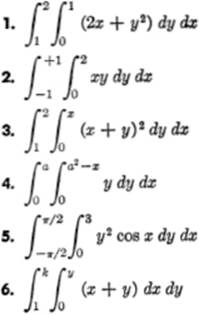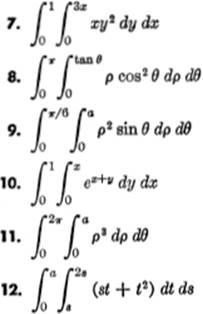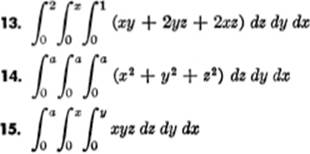The Calculus Primer (2011)
Part XVI. Successive and Partial Integration; Approximate Integration
Chapter 60. MULTIPLE INTEGRALS
16—1. Successive Integration. This is the inverse of the process of successive differentiation. Suppose it is given that
![]()
and we wish to find y. We may then write:
![]()
integrating:
![]()
Again:
![]()
integrating once more:
![]()
Finally:
![]()
and integrating,
![]()
The above analysis can also be written as follows:
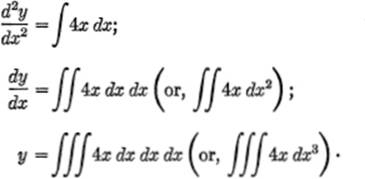
These last two are called a double integral and a triple integral, respectively. It will be seen that there is nothing new about successive integration, except that more than one constant of integration is involved. In general, a multipleintegral requires two or more successive integrations. The process is also known as repeated integration, or iterated integration.
EXAMPLE. Find y, if y = ![]() 3x2 dx dx dx.
3x2 dx dx dx.
Solution.
y = ![]() 3x2 dx dx dx
3x2 dx dx dx
= ![]() (x3 + C1) dx dx
(x3 + C1) dx dx
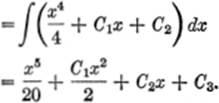
16—2. Multiple Integrals with Limits of Integration. If successive integrations are performed between limits, the constants of integration disappear.
EXAMPLE. Evaluate ![]() 3x dx dx dx.
3x dx dx dx.
Solution. Beginning by integrating the “inside” integral first:
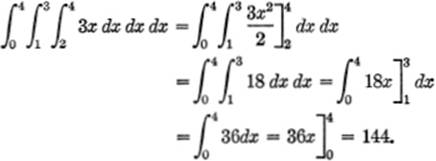
EXERCISE 16—1
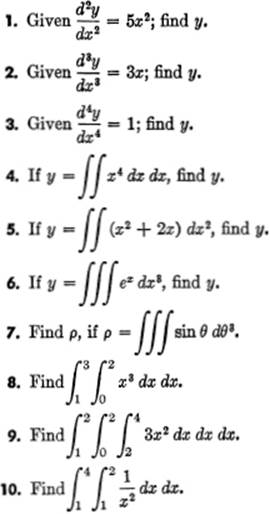

16—3. Successive Partial Integration. Just as we can find partial derivatives of a function of two or more variables, so we can also integrate the function f(x,y) in an analogous inverse process of partial differentiation. In the function f(x,y), where x and y are both independent variables, let us for a moment consider x as a constant, and let y vary; then f(x,y) becomes a function of y only. Now, under these conditions, suppose we integrate between the limits y = c and y = d; we then have:
![]()
Now the value of this integral will depend not only upon the value of y, but also upon the value of x; hence the entire expression in (1) may be regarded as a function of x. Under this condition, let us now integrate with respect to xbetween the limits x = a and x = b: the result becomes
![]()
which is generally written without the bracket as
![]()
The expression (3) is read: “the double integral of f(x,y) from y = c to y = d and from x = a to x = b.”
EXAMPLE 1. Find the value of the double integral
![]()
Solution. We perform the “y-integration” first, remembering to “hold” x constant:

Now we perform the second integration, or the “x-integration,” upon the expression in (1), this time “holding” y constant, and integrating with respect to x:
![]()
The limits of integration need not necessarily all be constants; very often the limits of y in the first integration are themselves functions of the variable x, as shown in the next two examples.
EXAMPLE 2. Find the value of
![]()
Solution. Integrating first with respect to y, we get:
![]()
Now, integrating with respect to x:
![]()
EXAMPLE 3. Find ![]()
Solution.

The same ideas may be extended to triple integrals.
EXAMPLE 4. Find the value of
![]()
Solution. Consider x and y both constant, and integrate with respect to the variable z:

Then perform the y-integration, remembering that x is a constant:
![]()
Finally, perform the x-integration:
![]()
EXERCISE 16—2
Find the value of each of the following multiple integrals:
